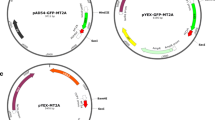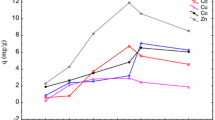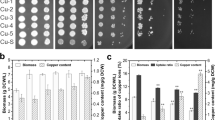Abstract
One key step of the bioremediation processes designed to clean up heavy metal contaminated environments is growing resistant cells that accumulate the heavy metals to ensure better removal through a combination of biosorption and continuous metabolic uptake after physical adsorption. Saccharomyces cerevisiae cells can easily act as cation biosorbents, but isolation of mutants that are both hyperaccumulating and tolerant to heavy metals proved extremely difficult. Instead, mutants that are hypersensitive to heavy metals due to increased and continuous uptake from the environment were considered, aiming to use such mutants to reduce the heavy metal content of contaminated waters. In this study, the heavy metal hypersensitive yeast strain pmr1∆ was investigated for the ability to remove Mn2+, Cu2+, Co2+, or Cd2+ from synthetic effluents. Due to increased metal accumulation, the mutant strain was more efficient than the wild-type in removing Mn2+, Cu2+, or Co2+ from synthetic effluents containing 1–2 mM cations, with a selectivity \( {\text{Mn}}^{{{\text{2}} + }} > {\text{Co}}^{{{\text{2}} + }} ~ > {\text{Cu}}^{{{\text{2}} + }} \) and also in removing Mn2+ and Cd2+ from synthetic effluents containing 20–50 μM cations, with a selectivity Mn2+ > Cd2+.







Similar content being viewed by others
References
Akhtar N, Iqbal J, Iqbal M (2004) Removal and recovery of nickel(II) from aqueous solution by loofa sponge-immobilized biomass of Chlorella sorokiniana: characterization studies. J Hazard Mater 108:85–94
Antebi A, Fink GR (1992) The yeast Ca2+-ATPase homologue, PMR1, is required for normal Golgi function and localizes in a novel Golgi-like distribution. Mol Biol Cell 3:633–654
Bender J, Phillips P (2004) Microbial mats for multiple applications in aquaculture and bioremediation. Bioresour Technol 94:229–238
Brachmann CB, Davies A, Cost GJ, Caputo E, Li J, Hieter P, Boeke JD (1998) Designer deletion strains derived from Saccharomyces cerevisiae S288C: a useful set of strains and plasmids for PCR-mediated gene disruption and other applications. Yeast 14:115–132
Bradford MM (1976) A rapid and sensitive method for the quantitation of microgram quantities of protein utilizing the principle of protein-dye binding. Anal Biochem 72:248–254
Brady D, Duncan JR (1994) Binding of heavy metals by the cell walls of Saccharomyces cerevisiae. Enzym Microb Tech 16:633–638
Cakar ZP, Alkim C, Turanli B, Tokman N, Akman S, Sarikaya M, Tamerler C, Benbadis L, Françios JM (2009) Isolation of cobalt hyper-resistant mutants of Saccharomyces cerevisiae by in vivo evolutionary engineering approach. J Biotechnol 143:130–138
Can C, Jianlong W (2007) Correlating metal ion characteristics with biosorption capacity using QSAR model. Chemosphere 69:1610–1616
Culotta VC, Yang M, Hall MD (2005) Manganese transport and trafficking: lessons learned from Saccharomyces cerevisiae. Eukaryot Cell 4:1159–1165
Dürr G, Strayle J, Plemper R, Elbs S, Klee SK, Catty P, Wolf DH, Rudolph HK (1998) The medial-Golgi ion pump Pmr1 supplies the yeast secretory pathway with Ca2+ and Mn2+ required for glycosylation, sorting, and endoplasmic reticulum-associated protein degradation. Mol Biol Cell 9:1149–1162
Engl A, Kunz B (2004) Biosorption of heavy metals by Saccharomyces cerevisiae: effects of nutrient conditions. J Chem Tech Biotechnol 63:257–261
Farcasanu IC, Hirata D, Tsuchiya E, Nishiyama F, Miyakawa T (1995) Protein phosphatase 2B of Saccharomyces cerevisiae is required for the tolerance to manganese, in blocking the entry of ions into the cells. Eur J Biochem 232:712–717
Farcasanu IC, Mizunuma M, Nishiyama F, Miyakawa T (2005) Role of L-histidine in conferring tolerance to Ni2+ in Sacchromyces cerevisiae cells. Biosci Biotechnol Biochem 69:2343–2348
Farkas E, Bátka D, Kremper G, Pócsi I (2008) Structure-based differences between the metal ion selectivity of two siderophores desferrioxamine B (DFB) and desferricoprogen (DFC): why DFC is much better Pb(II) sequestering agent than DFB? J Inorg Biochem 102:1654–1659
Feldmann H (2005) Yeast transport. In: Yeast molecular biology, A short compendium on basic features and novel aspects. Adolf-Butenandt-Institute, University of Munich, pp. 10–17. Available at http://biochemie.web.med.uni-muenchen.de/Yeast_Biol/
Kambe-Honjoh H, Ohsumi K, Shimoi H, Nakajima H, Kitamoto K (2000) Molecular breeding of yeast with higher metal-adsorption capacity by expression of histidine-repeat insertion in the protein anchored to the cell wall. J Gen Appl Microbiol 46:113–117
Kuroda K, Shibasaki S, Ueda M, Tanaka A (2001) Cell surface-engineered yeast displaying a histidine oligopeptide (exa-His) has enhanced adsorption of and tolerance to heavy metal ions. Appl Microbiol Biotechnol 57:697–701
Lapinskas PJ, Cunningham KW, Liu XF, Fink GR, Culotta VC (1995) Mutations in PMR1 suppress oxidative damage in yeast lacking superoxide dismutase. Mol Cell Biol 15:1382–1388
Lauer CM Jr, Bonatto D, Mielniczki-Pereira AA, Schuch AZ, Dias JF, Yoneama ML, Pêgas Henriques JA (2008) The Pmr1 protein, the major yeast Ca2+-ATPase in the Golgi, regulates intracellular levels of the cadmium ion. FEMS Microbiol Lett 285:79–88
Lloyd JR, Lovley DR, Macaskie LE (2003) Biotechnological application of metal-reducing microorganisms. Adv Appl Microbiol 53:85–128
Machado MD, Santos MS, Gouveia C, Soares HM, Soares EV (2008) Removal of heavy metals using a brewar’s yeast strain of Saccharomyces cerevisiae: the flocculation as a separation process. Bioresours Technol 99:2107–2115
Machado MD, Janssens S, Soares HM, Soares EV (2009) Removal of heavy metals using a brewar’s yeast strain of Saccharomyces cerevisiae: advantages of using dead biomass. J Appl Biotech 106:1792–1804
Malik A (2004) Metal bioremediation through growing cells. Environ Int 30:261–278
Mandal D, Woolf TB, Rao R (2000) Manganese selectivity of pmr1, the yeast secretory pathway ion pump, is defined by residue Gln783 in transmembrane segment 6. Residue Asp778 is essential for cation transport. J Biol Chem 275:23933–23938
Matsunaga T, Takeyama H, Nakao T, Yamazawa A (1999) Screening of microalgae for bioremediation of cadmium polluted seawater. J Biotechnol 70:33–38
Naeem A, Woertz JR, Fein JB (2006) Experimental measurement of proton, Cd, Pb, Sr and Zn adsorption onto the fungal species Saccharomyces cerevisiae. Environ Sci Technol 40:5724–5729
Pearce DA, Sherman F (1999) Toxicity of copper, cobalt, and nickel salts is dependent on histidine metabolism in the yeast Saccharomyces cerevisiae. J Bacteriol 181:4774–4779
Perez-Rama M, Alonso JA, Lopez CH, Vaamonde ET (2002) Cadmium removal by living cells of the marine microalgae Tetraselmis suecica. Bioresour Technol 84:265–270
Rudolph HK, Antebi A, Fink GR, Buckley CM, Dorman TE, LeVitre J, Davidow LS, Mao JI, Moir DT (1989) The yeast secretory pathway is perturbed by mutations in PMR1, a member of a Ca2+ ATPase family. Cell 58:133–145
Saleem M, Brim H, Hussain S, Arshad M, Leigh MB, Zia-ul H (2008) Perspectives on microbial cell surface display in bioremediation. Biotechnol Adv 26:151–161
Sherman F, Fink GR, Hicks JB (1986) Methods in yeast genetics. Cold Sprig Harbor Laboratory Press, Cold Spring Harbor, New York
Shibasaki S, Maeda H, Ueda M (2009) Molecular display technology using yeast-arming technology. Anal Sci 25:41–49
Sorin A, Rosas G, Rao R (1997) PMR1, a Ca2+-ATPase in yeast Golgi, has properties distinct from sarco/endoplasmic reticulum and plasma membrane calcium pumps. J Biol Chem 272:9895–9901
Tohoyama H, Inoue M, Joho M, Murayama T (1995) Production of metallothionein in copper- and cadmium-resistant strains of Saccharomyces cerevisiae. J Ind Microbiol 14:126–131
Van Ho A, Ward DM, Kaplan J (2002) Transition metal transport in yeast. Annu Rev Microbiol 56:237–261
Villegas LB, Fernàndez PM, Amoroso MJ, de Figueroa LI (2008) Chromate removal by yeasts isolated from tanning factory and a mine site in Argentina. Biometals 21:591–600
Wang J, Chen C (2006) Biosorption of heavy metals by Saccharomyces cerevisiae: a review. Biotechnol Adv 24:427–451
Wang J, Chen C (2009) Biosorbents for heavy metals removal and their future. Biotechnol Adv 27:195–226
Acknowledgements
This work was supported by the Ministry of Education and Research of Romania through the grants-in-aid CNCSIS 1643/2007 and PNII Idei_965, 176/2007. We are grateful to Florin Ruta for carrying out the AAS measurements.
Author information
Authors and Affiliations
Corresponding author
Rights and permissions
About this article
Cite this article
Ruta, L., Paraschivescu, C., Matache, M. et al. Removing heavy metals from synthetic effluents using “kamikaze” Saccharomyces cerevisiae cells. Appl Microbiol Biotechnol 85, 763–771 (2010). https://doi.org/10.1007/s00253-009-2266-3
Received:
Revised:
Accepted:
Published:
Issue Date:
DOI: https://doi.org/10.1007/s00253-009-2266-3




